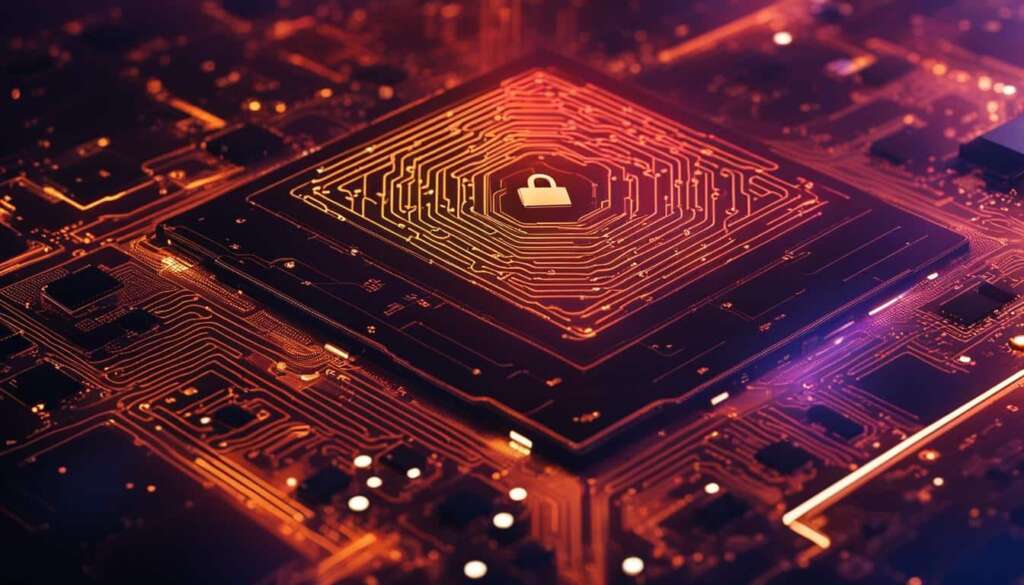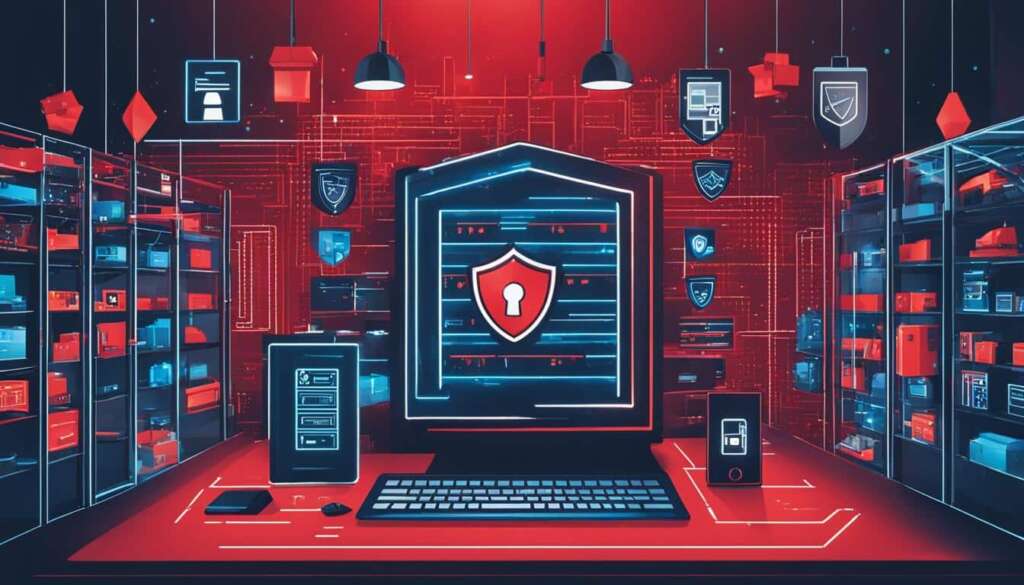Table of Contents
Blockchain technology has emerged as a game-changer in the world of cybersecurity. With its secure blockchain and decentralised ledger, it offers innovative solutions to combat cyber threats and ensure secure data storage and transactions. The encryption and authentication capabilities of blockchain provide a robust layer of protection against cyber attacks and fraud.
By leveraging blockchain technology, organisations can strengthen their cybersecurity defences and prevent cyber threats. The use of a decentralised ledger ensures the integrity and immutability of data, making it tamper-proof and secure. With blockchain’s secure authentication and transaction endorsement, organisations can ensure the authenticity of transactions and prevent unauthorized access.
Cyber threat prevention is a critical aspect of cybersecurity, and blockchain technology plays a significant role in addressing these challenges. Its secure and transparent nature allows for real-time monitoring and detection of potential cyber threats. By implementing blockchain encryption and secure communication, businesses can safeguard their sensitive information and prevent data breaches.
In today’s digital landscape, where cyber threats are constantly evolving, it is crucial to adopt innovative cybersecurity solutions. Blockchain technology provides the necessary tools and framework to mitigate risks and protect against cyber attacks. With its decentralised ledger, secure data storage, and authentication mechanisms, blockchain is paving the way for a secure and trustworthy future of online security.
Basic Principles of Blockchain Security
Blockchain technology is built upon a foundation of core principles that contribute to its robust security. Understanding these principles is essential for comprehending the inherent security qualities of blockchain networks. The three fundamental principles of blockchain security are decentralization, consensus mechanism, and data validation.
Decentralization: Decentralization is a key principle of blockchain technology. Unlike traditional centralized systems, blockchain networks operate on a distributed network of computers, known as nodes. This decentralized architecture eliminates the risk of a single point of failure, making it extremely difficult for hackers to compromise the integrity of the network.
Consensus Mechanism: Consensus mechanisms ensure that all participants in a blockchain network agree on the validity of transactions. This agreement is achieved through a process of verification and validation, where transactions are authenticated and approved by the network’s participants. Consensus mechanisms, such as Proof of Work (PoW) or Proof of Stake (PoS), contribute to the trust and reliability of blockchain transactions.
Data Validation: Data validation is a critical aspect of blockchain security. Each transaction within a block is validated and verified by multiple nodes in the network. This validation process ensures the accuracy and integrity of the data recorded on the blockchain. Once a transaction is added to the blockchain, it becomes virtually impossible to alter or tamper with, providing a secure and transparent record of transactions.
By adhering to the basic principles of blockchain security, organizations can leverage the inherent security qualities of blockchain technology to protect their data and ensure trust in transactions.
Additional Resources:
- Understanding Blockchain Technology: A Comprehensive Guide
- Blockchain Consensus Mechanisms: Explained
- Data Validation in Blockchain: Ensuring Trust and Integrity
Different Types of Blockchain Networks
Blockchain technology is not a one-size-fits-all solution and offers various types of networks to cater to different needs and requirements. Understanding the different types of blockchain networks can help organizations make informed decisions when implementing blockchain for their cybersecurity needs.
Public Blockchains
Public blockchains are open and accessible to anyone who wants to join and participate in the network. These blockchains are permissionless, meaning there are no restrictions on who can join or validate transactions. Public blockchains provide a high level of decentralization, as multiple participants across the globe validate and secure the network. Bitcoin and Ethereum are examples of popular public blockchains.
Private Blockchains
Private blockchains, on the other hand, are restricted to a select group of known participants. These blockchains require identity verification and limit membership to organizations or individuals who have been granted access. Private blockchains are often used by enterprises that require greater control over their blockchain network and want to ensure privacy and security. Private blockchains offer higher transaction speeds and can be more efficient than public blockchains.
Permissioned Blockchains
Permissioned blockchains are a subset of private blockchains where access is restricted to a specific set of users. These users are granted identities using certificates, ensuring that only authorized participants can validate transactions and contribute to the network’s consensus mechanism. Permissioned blockchains are commonly used in enterprise settings where compliance and regulatory requirements need to be met.
Permissionless Blockchains
Permissionless blockchains, also known as open blockchains, have no restrictions on participation. Anyone can join and validate transactions on the network without requiring authorization. Permissionless blockchains offer a high level of decentralization, transparency, and security, but they may be slower and require more computational resources compared to permissioned blockchains. Bitcoin’s blockchain is an example of a permissionless blockchain.
| Type of Blockchain | Description |
|---|---|
| Public Blockchain | An open network accessible to anyone, with no restrictions on participation. |
| Private Blockchain | A restricted network limited to known participants, offering greater control and privacy. |
| Permissioned Blockchain | A blockchain with restricted access, requiring identity verification and compliance with specific rules. |
| Permissionless Blockchain | An open blockchain with no restrictions on participation, offering high decentralization and transparency. |
Understanding the different types of blockchain networks allows organizations to choose the most suitable option based on their specific needs and requirements. Whether opting for a public, private, permissioned, or permissionless blockchain, it is important to consider factors such as decentralization, privacy, scalability, and compliance to ensure the successful implementation of blockchain technology for cybersecurity purposes.
Cybersecurity Risks in Blockchain Technology
Despite its inherent security qualities, blockchain technology is not immune to cyberattacks and fraudulent activities. Various vulnerabilities exist in the blockchain infrastructure that hackers can exploit to compromise the security of the network. Understanding and mitigating these risks is crucial for ensuring the integrity and confidentiality of blockchain applications.
Vulnerabilities and Risks
Blockchain technology faces several cybersecurity risks, including:
- Cyberattacks: Hackers can exploit weaknesses in the blockchain infrastructure to carry out a range of attacks, such as code exploitation, phishing attacks, routing attacks, and Sybil attacks. These attacks can compromise the confidentiality, integrity, and availability of the blockchain network.
- Fraud: Blockchain networks can be susceptible to various forms of fraud, such as stolen keys and employee computer hacks. Unauthorized access to private keys can enable hackers to manipulate transactions and compromise the security of the blockchain.
Protective Measures
To mitigate these risks, organizations implementing blockchain technology should consider the following protective measures:
- Encryption and Authentication: Implement strong encryption algorithms and authentication mechanisms to secure the data and transactions within the blockchain network.
- Secure Key Management: Employ robust key management practices to protect private keys and prevent unauthorized access.
- Employee Training and Awareness: Educate employees about the potential risks and best practices for securely using blockchain technology to prevent common vulnerabilities, such as phishing attacks.
- Regular Security Audits: Conduct regular security audits to identify and address any vulnerabilities or weaknesses in the blockchain infrastructure.
The Importance of Cybersecurity in Blockchain
“As blockchain technology continues to revolutionize various industries, ensuring robust cybersecurity measures becomes even more critical. By understanding the vulnerabilities and risks associated with blockchain technology and implementing appropriate protective measures, organizations can leverage its benefits while safeguarding against potential cyber threats and fraudulent activities.”
By recognizing and addressing the cybersecurity risks in blockchain technology, organizations can enhance the security of their blockchain applications and protect sensitive data and transactions from unauthorized access and manipulation.
| Cybersecurity Risks | Protective Measures |
|---|---|
| Cyberattacks | Encryption and Authentication |
| Fraud | Secure Key Management |
Blockchain Security for the Enterprise
When implementing blockchain technology for enterprise applications, it is essential to prioritize security at all levels of the technology stack. A robust security strategy is crucial to protect sensitive data and ensure the integrity of transactions. Here are some key considerations for achieving blockchain security in the enterprise.
Identity and Access Management
One of the foundational elements of blockchain security is implementing a robust identity and access management (IAM) system. This involves verifying the identities of participants and granting appropriate access privileges. By controlling access to the blockchain network, organizations can prevent unauthorized actions and maintain data integrity.
Key Management
Proper key management is essential to protect the cryptographic keys that secure blockchain transactions. Organizations must implement secure key storage and establish strong key management practices, such as regular key rotation and multi-factor authentication. This helps safeguard against unauthorized access and potential key compromises.
Data Privacy and Secure Communication
Data privacy is a critical concern in enterprise blockchain applications. It is important to ensure that sensitive data is encrypted both at rest and in transit. Secure communication protocols, such as Transport Layer Security (TLS), should be used to protect data exchanged between participants. By prioritizing data privacy and secure communication, organizations can mitigate the risk of data breaches and unauthorized access to sensitive information.
Smart Contract Security and Transaction Endorsement
Smart contracts are an integral part of blockchain applications, and ensuring their security is essential. Organizations should conduct thorough code reviews and implement rigorous testing to identify and address vulnerabilities. Additionally, transaction endorsement mechanisms should be implemented to verify the validity of transactions and prevent malicious activity on the blockchain network.

| Security Strategy | Importance |
|---|---|
| Identity and Access Management (IAM) | Control access and prevent unauthorized actions |
| Key Management | Protect cryptographic keys and prevent key compromises |
| Data Privacy and Secure Communication | Encrypt sensitive data and secure data exchange |
| Smart Contract Security and Transaction Endorsement | Ensure secure execution of smart contracts and validate transactions |
Best Practices for Blockchain Security
When implementing a blockchain solution for cybersecurity, several best practices should be followed to ensure the highest level of security and protection. These practices include:
- Governance Model: Establishing a well-defined governance model is crucial for a successful blockchain implementation. This model outlines the roles and responsibilities of participants, decision-making processes, and dispute resolution mechanisms.
- Data Capture: Identifying the relevant data to be captured within each block is essential. This includes determining the specific information that needs to be recorded and stored, ensuring accurate and comprehensive data for analysis and auditing purposes.
- Regulatory Requirements: Understanding and adhering to relevant regulatory requirements is critical to ensure compliance and avoid legal issues. Compliance with data protection regulations, identity verification protocols, and anti-money laundering regulations is of utmost importance.
- Identity Management: Implementing a robust identity management system ensures that only authorized individuals can participate in the blockchain network. This includes strong authentication and access controls to protect against unauthorized access and data breaches.
- Disaster Recovery Plan: Having a comprehensive disaster recovery plan in place is vital to ensure business continuity in the event of unforeseen incidents or system failures. This plan should include data backups, redundancy measures, and a clear process for restoring operations.
- Minimal Security Posture: Implementing a minimal security posture ensures that all participants in the blockchain network adhere to a standard set of security practices. This includes regular security assessments, vulnerability scanning, and continuous monitoring to detect and mitigate potential threats.
- Logic for Resolving Blockchain Block Collisions: Block collisions can occur when multiple blocks are created simultaneously, leading to conflicts in the blockchain. Establishing a clear logic for resolving these collisions ensures the integrity and consistency of the blockchain network.
By following these best practices, organizations can effectively enhance the security and resilience of their blockchain solutions. It is important to note that these practices should be tailored to the specific needs and requirements of each organization, taking into account industry regulations, internal policies, and risk tolerance.
The Role of Blockchain in Cybersecurity
Blockchain technology has emerged as a powerful tool in addressing cybersecurity challenges posed by artificial intelligence, machine learning, and botnets. Traditional security methods often struggle to keep pace with the rapidly evolving threat landscape, leaving vulnerabilities that can be exploited by cybercriminals. Blockchain technology offers a new approach to secure communications, data integrity verification, and authentication, making it an invaluable asset in the fight against cyber threats.
One of the key benefits of blockchain technology in cybersecurity is its ability to provide a distributed ledger system. This decentralized approach reduces the risks associated with centralized data storage, making it harder for cybercriminals to compromise sensitive information. Additionally, the collaborative consensus mechanism employed by blockchain enhances authentication, ensuring that only legitimate transactions are recorded and accepted.
“Blockchain technology offers a new approach to secure communications, data integrity verification, and authentication, making it an invaluable asset in the fight against cyber threats.”
Enhancing Data Security
Blockchain technology provides stronger encryption methods compared to traditional approaches. By leveraging cryptographic techniques, blockchain ensures that data remains secure and tamper-proof. The use of digital signatures further enhances data integrity, making it difficult for cybercriminals to modify or manipulate information recorded on the blockchain.
Protecting Against Advanced Threats
Artificial intelligence, machine learning, and botnets are increasingly being used by cybercriminals to launch sophisticated attacks. Blockchain technology can help organizations combat these advanced threats by providing a secure and transparent platform for data exchange. The decentralized nature of blockchain also makes it resilient to attacks, as there is no single point of failure that can be exploited.
The Future of Cybersecurity
As the cybersecurity landscape continues to evolve, businesses and organizations need to adopt innovative solutions to protect their sensitive information. Blockchain technology offers a promising future in the field of cybersecurity, providing enhanced security measures, secure communication channels, and a decentralized approach to data storage and verification.

Advantages of Blockchain in Cybersecurity
Blockchain technology offers several key advantages in the field of cybersecurity. Its decentralized nature and collaborative consensus algorithm make it difficult for cybercriminals to compromise data. With blockchain, data is stored across a network of computers, eliminating the need for a central authority. This decentralization ensures that no single entity has control over the entire system, reducing the risk of data breaches and unauthorized access.
Another advantage of blockchain in cybersecurity is its use of strong encryption practices. Each transaction recorded in a blockchain is encrypted and linked to previous transactions, creating an immutable record. This ensures that data stored in the blockchain cannot be altered or tampered with, providing a high level of data integrity and security. Additionally, blockchain technology can protect Internet of Things (IoT) devices by providing secure communication protocols and preventing unauthorized access.
Blockchain can also help prevent distributed denial-of-service (DDoS) attacks. By distributing data across multiple nodes in the network, blockchain makes it difficult for attackers to overwhelm a single point of failure. This decentralized approach can mitigate the impact of DDoS attacks and ensure the availability of critical services. Furthermore, blockchain technology addresses data privacy concerns by providing transparent yet secure data storage and sharing. With blockchain, users can have greater control over their personal data and ensure that it is only accessed by authorized parties.
Finally, smart contract security is another advantage of blockchain in cybersecurity. Smart contracts are self-executing agreements that are stored and executed on the blockchain. They can automate complex processes and enforce predetermined rules without the need for intermediaries. By leveraging blockchain technology, organizations can ensure the security and integrity of their smart contracts, reducing the risk of fraud and disputes.

Advantages of Blockchain in Cybersecurity:
- Decentralization: Reduces the risk of data breaches and unauthorized access by eliminating the need for a central authority.
- Collaborative Consensus: Difficult for cybercriminals to compromise data due to the collective agreement on transaction validity.
- Strong Encryption Practices: Each transaction in the blockchain is encrypted, ensuring data integrity and security.
- Immutable Records: Data stored in the blockchain cannot be altered or tampered with, providing a high level of integrity.
- IoT Protection: Blockchain technology can secure IoT devices and prevent unauthorized access.
- DDoS Attack Prevention: Distributes data across multiple nodes, making it difficult for attackers to overwhelm the system.
- Data Privacy: Provides transparent yet secure data storage and sharing, giving users greater control over their data.
- Smart Contract Security: Ensures the security and integrity of self-executing agreements stored on the blockchain.
Challenges and Considerations in Implementing Blockchain for Cybersecurity
Data privacy, scalability, regulations, interoperability, and technology risks are key challenges and considerations when implementing blockchain for cybersecurity. These factors can impact the effectiveness and security of blockchain solutions, requiring careful planning and implementation to ensure optimal outcomes.
Data privacy is a critical concern when it comes to blockchain technology. While blockchain offers transparency and immutability, public blockchains may expose transaction details to unauthorized parties. Implementing permissioned blockchains can help address data privacy concerns by providing selective access to transactions, ensuring sensitive information remains protected.
Scalability is another challenge in blockchain implementation. The size of each block and response times can impact the efficiency of blockchain networks, especially when handling a large number of transactions. Scalability solutions, such as sharding and off-chain transactions, can help overcome these limitations and ensure the smooth operation of blockchain systems.
Regulations play a crucial role in blockchain implementation, as the technology may need to comply with specific industry or regional requirements. Ensuring compliance with data protection, privacy, and financial regulations can be challenging, particularly when dealing with cross-border transactions. Organizations must carefully navigate regulatory frameworks to avoid legal complications and maintain the integrity of their blockchain systems.
Interoperability is a consideration when integrating blockchain with existing systems or collaborating with multiple parties. The ability of different blockchain platforms to communicate and share data seamlessly is crucial for achieving operational efficiency and collaboration. Developing interoperability standards and frameworks is essential to facilitate the integration of blockchain solutions into diverse ecosystems.
Technology risks encompass various challenges, including improper key management and access control, unintended forks, and inadequate encryption schemes. Addressing these risks requires a robust security model that combines blockchain security controls, conventional security controls, and business controls. Organizations must ensure the proper implementation of security measures to mitigate technology risks and protect the integrity of their blockchain systems.
| Challenges | Considerations |
|---|---|
| Data privacy | Selective access to transactions in permissioned blockchains |
| Scalability | Sharding and off-chain transactions for efficient operations |
| Regulations | Compliance with data protection, privacy, and financial regulations |
| Interoperability | Development of interoperability standards and frameworks |
| Technology risks | Implementation of robust security measures |
Addressing these challenges and considerations is vital to the successful implementation of blockchain for cybersecurity. While blockchain technology offers significant advantages in terms of security and data protection, careful planning and consideration of these factors will ensure that organizations can harness the full potential of blockchain in safeguarding against cyber threats.
Conclusion
Blockchain Technology in Cybersecurity is poised to revolutionise the way we protect our data. By harnessing the inherent security qualities of blockchain, organisations can strengthen their cybersecurity defenses and defend against cyber threats more effectively. With comprehensive security strategies and the adoption of blockchain solutions, the future of online security looks promising.
Blockchain technology offers secure data protection through its decentralized nature and collaborative consensus. By implementing strong encryption practices and ensuring data integrity, blockchain provides a robust defense against cybercriminals. The immutability of blockchain records ensures that unauthorized modifications are prevented, enhancing the security of sensitive information.
With the potential to protect Internet of Things (IoT) devices, mitigate DDoS attacks, and address data privacy concerns, blockchain technology is paving the way for the future of online security. However, it’s important to address challenges such as data privacy, scalability, regulations, interoperability, and technology risks to fully harness the potential of blockchain in cybersecurity.
By leveraging the advantages of blockchain technology and tailoring security strategies to specific business needs, organisations can create a secure environment for their data and protect against cyber threats. The future of online security lies in embracing blockchain technology and its potential to revolutionise the way we safeguard our information.
FAQ
What is blockchain security?
Blockchain security is a comprehensive risk management system for a blockchain network, using cybersecurity frameworks, assurance services, and best practices to reduce risks against attacks and fraud.
What are the basic principles of blockchain security?
Blockchain technology is based on principles such as cryptography, decentralization, and consensus. Each block in a blockchain contains a transaction or a bundle of transactions, and these blocks are cryptographically linked in such a way that it is nearly impossible to tamper with the data. All transactions within the blocks are validated and agreed upon by a consensus mechanism, ensuring the accuracy and truthfulness of the transactions.
What are the different types of blockchain networks?
Blockchain networks can be categorized as public or private, and permissioned or permissionless. Public blockchains allow anyone to join and participate anonymously, while private blockchains require identity verification and limit membership to known organizations. Permissioned blockchains restrict access to a select set of users who are granted identities using certificates. Permissionless blockchains have no restrictions on participants.
What are the cybersecurity risks in blockchain technology?
While blockchain technology provides a tamper-proof ledger, it is still vulnerable to cyberattacks and fraud. Hackers can exploit vulnerabilities in blockchain infrastructure, leading to code exploitation, theft of private keys, and compromise of employee computers. Common cyberattacks on blockchain technology include phishing attacks, routing attacks, Sybil attacks, and 51% attacks.
How can blockchain be used for enterprise cybersecurity?
When building an enterprise blockchain application, it is crucial to consider security at all layers of the technology stack. A comprehensive security strategy includes implementing identity and access management, key management, data privacy, secure communication, smart contract security, and transaction endorsement.
What are the best practices for blockchain security?
When designing a blockchain solution, it is important to address key questions such as the governance model for participating organizations, the data to be captured in each block, relevant regulatory requirements, identity management, disaster recovery planning, minimal security posture for participants, and the logic for resolving blockchain block collisions.
What is the role of blockchain in cybersecurity?
Blockchain technology can play a crucial role in cybersecurity by reducing vulnerabilities and providing stronger encryption and data integrity verification. It offers a distributed ledger system that reduces risks associated with centralized data storage and allows for collaborative consensus, enhancing authentication and securing data communication.
What are the advantages of blockchain in cybersecurity?
Blockchain technology offers several advantages in cybersecurity. Its decentralized nature and collaborative consensus algorithm make it difficult for cybercriminals to compromise data. Strong encryption practices and digital signatures ensure secure communication and data integrity. The immutability of blockchain records prevents unauthorized modifications. Blockchain can also protect Internet of Things (IoT) devices and mitigate distributed denial-of-service (DDoS) attacks.
What are the challenges and considerations in implementing blockchain for cybersecurity?
Implementing blockchain for cybersecurity presents challenges such as data privacy concerns, scalability constraints, compliance with regulations, interoperability issues, and technology risks. These challenges must be carefully addressed to ensure the security of blockchain solutions.
What is the future of online security with blockchain technology?
Blockchain technology has the potential to revolutionize cybersecurity by providing secure data protection through its inherent security qualities. By implementing blockchain solutions and addressing the challenges and considerations mentioned, organizations can fortify their cybersecurity defenses and safeguard against cyber threats.
Source Links
- https://www.infosys.com/insights/cyber-security/cybersecurity-blockchain.html
- https://www.ibm.com/topics/blockchain-security
- https://www.upguard.com/blog/the-role-of-cybersecurity-in-blockchain-technology














1 comment
[url=http://acyclovirmc.com/]acyclovir in mexico[/url]